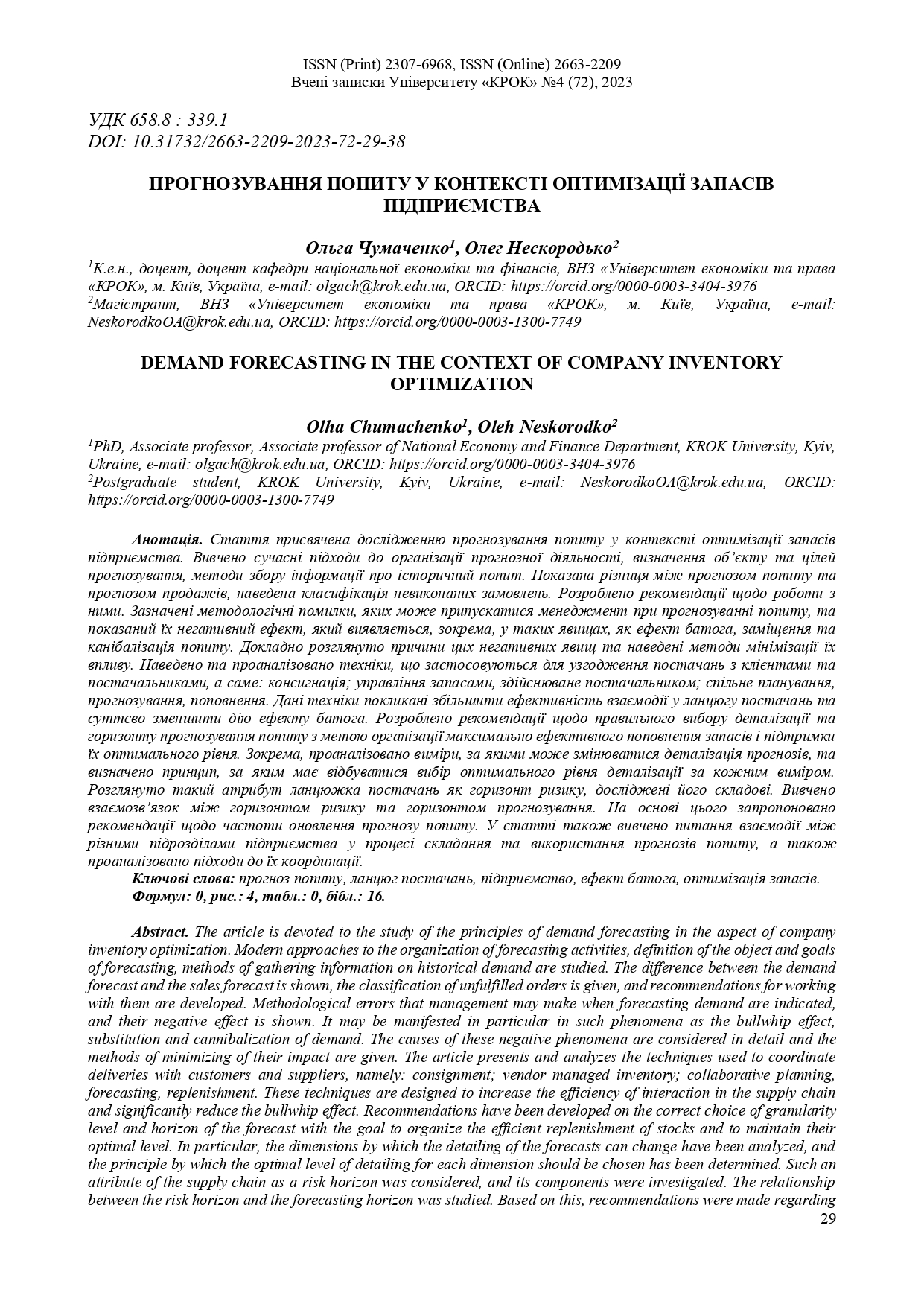DEMAND FORECASTING IN THE CONTEXT OF COMPANY INVENTORY OPTIMIZATION
DOI:
https://doi.org/10.31732/2663-2209-2023-72-29-38Keywords:
demand forecasting, supply chain, company, bullwhip effect, inventory optimizationAbstract
The article is devoted to the study of the principles of demand forecasting in the aspect of company inventory optimization. Modern approaches to the organization of forecasting activities, definition of the object and goals of forecasting, methods of gathering information on historical demand are studied. The difference between the demand forecast and the sales forecast is shown, the classification of unfulfilled orders is given, and recommendations for working with them are developed. Methodological errors that management may make when forecasting demand are indicated, and their negative effect is shown. It may be manifested in particular in such phenomena as the bullwhip effect, substitution and cannibalization of demand. The causes of these negative phenomena are considered in detail and the methods of minimizing of their impact are given. The article presents and analyzes the techniques used to coordinate deliveries with customers and suppliers, namely: consignment; vendor managed inventory; collaborative planning, forecasting, replenishment. These techniques are designed to increase the efficiency of interaction in the supply chain and significantly reduce the bullwhip effect. Recommendations have been developed on the correct choice of granularity level and horizon of the forecast with the goal to organize the efficient replenishment of stocks and to maintain their optimal level. In particular, the dimensions by which the detailing of the forecasts can change have been analyzed, and the principle by which the optimal level of detailing for each dimension should be chosen has been determined. Such an attribute of the supply chain as a risk horizon was considered, and its components were investigated. The relationship between the risk horizon and the forecasting horizon was studied. Based on this, recommendations were made regarding the frequency of the demand forecast update. The article also examines the issue of interaction between different divisions of the enterprise in the process of making and using demand forecasts, as well as approaches to their coordination.
Downloads
References
Азьмук, Л.А. & Щербатюк, О.М. (2014). Мікроекономічний аналіз. Київ : КНЕУ. Доступ через: https://ir.kneu.edu.ua/server/api/core/bitstreams/21f8a14a-a296-49dd-923b-731488c4eb95/content
Андрейшина, Н.Б. (2013). Концептуальний підхід щодо прогнозування попиту. Бізнес-Інформ, 6, 120-124. Доступ через: https://www.business-inform.net/pdf/2013/6_0/120_124.pdf
Грушко, В.І., Наконечна О.С. & Чумаченко, О.Г. (2019). Фінанси : підручник. Київ : Видавництво Ліра-К. Доступ через: https://lira-k.com.ua/books/ekonomichni/finansy-gotujetsja-do-druku.html
Заруба, В.Я. & Парфентенко, І.А. (2020). Кількісні методи в управлінні маркетингом. Харків : НТУ «ХПІ». Доступ через: https://repository.kpi.kharkov.ua/server/api/core/bitstreams/ee0fd980-1393-45b3-ba86-b227698eaa9b/content
Зозульов, О.В., Царьова, Т.О. & Гавриш, Ю.О. (2022). Фундаментальний маркетинг : навчально-методичний комплекс. Київ : КПІ. Доступ через: https://ela.kpi.ua/bitstream/123456789/51901/1/Fundamentalnyi_marketynh_NMK.pdf
Kotler, P. & Keller, K. (2021). Marketing Management. Pearson Education Limited, Harlow. Доступ через: https://t1p.de/mxrbc
Нефьодов, Л.І. (2012). Математична модель прогнозування попиту на товари. Вісник Нац. техн. ун-ту «ХПІ», збірник наукових праць, 1, 27-38. Доступ через: https://repository.kpi.kharkov.ua/handle/KhPI-Press/5754
Румик, І. (2020). Продовольча безпека держави: питання теорії, методології, практики : монографія. Київ: ВНЗ «Університет економіки та права «КРОК». DOI: https://doi.org/10.31732/FS
Румик, І. & Пижьянов, С. (2022). Економічні підходи до функціонування системи маркетингу на промислових підприємствах. Вчені записки Університету «КРОК», 4(68), 9-19. DOI: https://doi.org/10.31732/2663-2209-2022-68-9-19
Румик, І. & Пилипенко, О. (2021). Антикризове управління при реалізації санаційних заходів підприємства. Вчені записки Університету «КРОК», 3(63), 51-60. DOI: https://doi.org/10.31732/2663-2209-2021-63-51-60
Румик, І. & Пилипенко, О. (2022). Фінансове забезпечення підприємств: можливості використання когнітивного моделювання. Вчені записки Університету «КРОК», 2(66), 44-52. DOI: https://doi.org/10.31732/2663-2209-2022-66-44-52
Tennent, J. (2013). Guide to financial management. Second edition. Profile Books Ltd. Доступ через: https://profilebooks.com/work/the-economist-guide-to-financial-management-3rd-edition/
Vandeput, N. (2020). Inventory Optimization. Walter de Gruyter GmbH, Berlin/Boston. Доступ через: https://www.degruyter.com/document/doi/10.1515/9783110673944/html
Vandeput, N. (2023). Demand Forecasting Best Practices. Manning Publications Co., Shelter Island NY. Доступ через: https://www.oreilly.com/library/view/demand-forecasting-best/9781633438095/
Федусенко, Є.В. (2010). Моделювання і прогнозування попиту методами багатокритеріальної оптимізації. Управління розвитком складних систем, 3, 66-70. Доступ через: https://urss.knuba.edu.ua/files/zbirnyk-4/65-68_0.pdf
Чумаченко, О.Г. (2019). Фінансовий контролінг: синонім управління чи контролю? Держава, регіони, підприємництво: інформаційні, суспільно-правові, соціально-економічні аспекти розвитку : матеріали міжнародної конференції (м. Київ, 21-22 листопада 2019 р.). Київ : Університет «КРОК». Доступ через: https://www.krok.edu.ua/ua/pro-krok/spivrobitniki/chumachenko-olga-grigorivna

Downloads
Published
How to Cite
Issue
Section
License

This work is licensed under a Creative Commons Attribution-NonCommercial 4.0 International License.

